Special Education In Oklahoma
A Step in the Right Direction:
Peer-Partners Club & Beyond
By: Esther Niang, Lauryn Thomas, Amelia Jáuregui, and Olivia Bloomfield

Pictured from left to right: Kelsie Tate, Emma Edwards, Kaylee Linsenmeyer, and Karie Linsenmeyer
“We need to get these kids out in the community,” Stillwater High School Adaptive Physical Education teacher Karie Linsenmeyer said, “and we need our community to see these kids and take part in [being involved].”
Special Services at Stillwater Public Schools offer programs to assist their Stillwater student population in need. The Peer-Partners club meets once a month or more to plan events that members can enjoy.
According to lessonplanet.com, a peer partner is “a student who can effectively assist a special-needs or challenged student without pushing, controlling, or dominating them”.
The purpose of the club at Stillwater High School is to pair a student with another who is in the special-needs program. Additionally, this partnership encourages community and friendship within the class or school.
“[Peer-Partners] is a club that we have in the school but it’s also a state organization that coincides with Special Olympics Oklahoma,” Linsenmeyer said, “And what we do is we have a club for the general education students, and we pair them with the Special Olympian athletes that are on our Special Olympics team.”
One of the Special Services teachers, Kelsie Tate, has looked over this program since she joined the Stillwater Public Schools system two years ago. Tate and Linsenmeyer often work together to ensure the students succeed in their academics as well as outside the classroom.
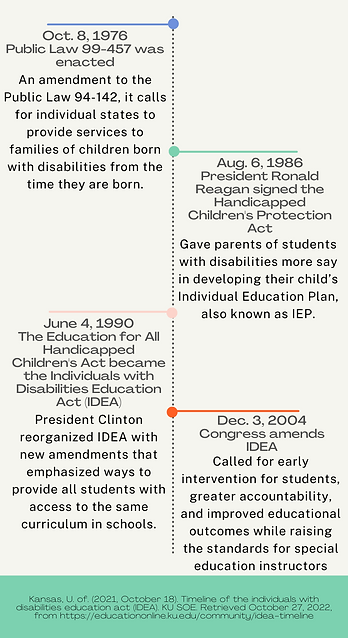
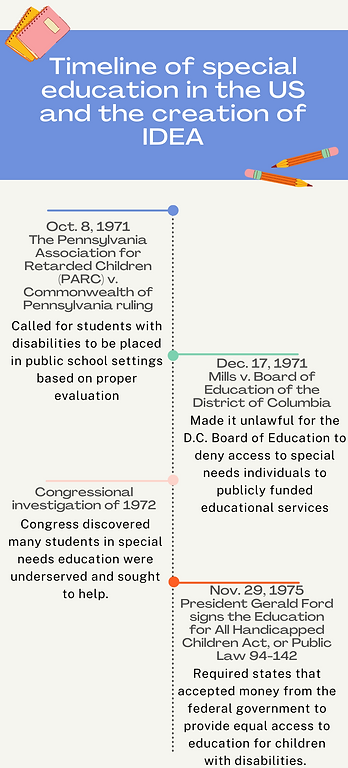
Timeline of special education in the US and the formation of IDEA by Esther Niang
One of the Special Services teachers, Kelsie Tate, has looked over this program since she joined the Stillwater Public Schools system two years ago. Tate and Linsenmeyer often work together to ensure the students succeed in their academics as well as outside the classroom.
As stated by the University of Kansas, more than half of the eight million students with disabilities at that time did not receive a proper education. Originally titled the Education for All Handicapped Children Act or Public Law 94-142, it sought to solve the issues that came with this discovery.
According to the University of Kansas’s School of Education and Human Sciences, special-needs students were often placed into special classrooms that separated them from the rest of the student body and failed to support their specific learning needs.
Dr. Candace Schell, associate professor of Special Education at Oklahoma State University, recalls her brother’s rough experiences at school when he was young. He was often left out of class parties and secluded from his classmates due to his diagnosis of emotional disturbance.
Dr. Schell remembers discussing with her high school counselor about her future. “I told my high school counselor I wanted to be a special education teacher because I was looking into colleges that offer [that subject],” Dr. Schell said, “and she told me it was a waste of my intelligence to teach special education.”
As reported by atlascorps.org, similar thoughts to the high school counselor’s and harmsful stereotypes are common and affect the care and education of people with special-needs.
In 2004, Congress made changes to IDEA by advocating for improvements made to education for special-needs students and raising the standards for educators in this field.
Programs and services have been created for special-needs individuals that offer assistance for things from academics to daily life.
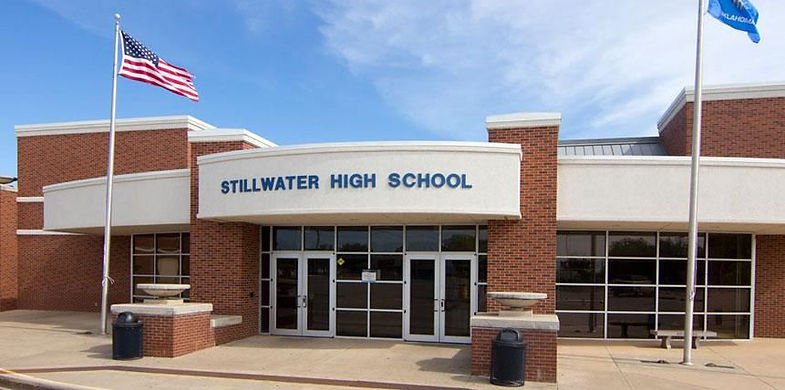
Courtesy of Stillwater Public Schools
Kaylee Linsenmeyer is President of the Peer Partners club at Stillwater High School and sees the importance of the club and related programs.
She especially enjoys experiencing the Special Olympics events with her fellow students. “When we go to Special Olympics, [I love] just seeing how excited the kids are and how much they love it,” Kaylee said.
Special Olympics was founded by Eunice Kennedy Shriver, an American philanthropist and a member of the Kennedy family. According to sook.org, Oklahoma’s first Special Olympics event was held at the University of Tulsa in 1969.
Today, the organization’s mission is to provide special-needs individuals to maintain their physical health, show courage and experience close bonds with the community. It has benefitted over 12 thousand athletes and gains support from over thousands of volunteer coaches, donors and sponsors.
Emma Edwards, a student in the Peer-Partners program, enjoys participating in Special Olympics events as an athlete playing Bocce for the high school.
Bocce is an Italian game that was established as part of Special Olympics in 1991. It was played by attempting to roll the Bocce ball the closest to a target ball called a “pallina”. As a sport, it provides a way for players with special-needs to gain self-confidence and develop physically.
When asked what she liked about being a student, Edwards recalls her proudest moment with a smile. “Winning first place in Bocce and everyone was really proud of me.”
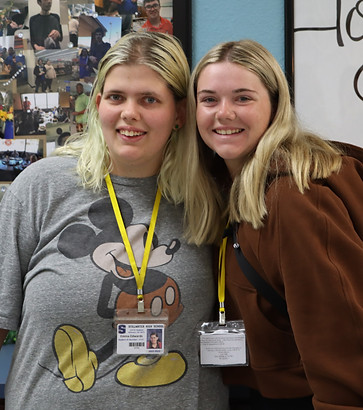
Left to right: Emma Edwards and Kaylee Linsenmeyer
Besides being in the Special Olympics, Edwards also participates in the Pathfinders program that the high school introduced close to five years ago. According to Tate, she and the students in the program work on job and transitional skills to be ready for life after high school graduation.
As part of the Pathfinders program, Edwards is given encouragement and help from her fellow students and teachers.
“I’m able to be out in the community and have fun,” Edwards states, “[My favorite part] is being able to stay at school and see my friends.”
“We’re always building, we’re always learning,” Tate said, “[We’re] making new programs to benefit our students in particular. That is something our administration always encourages us and supports us in doing.”
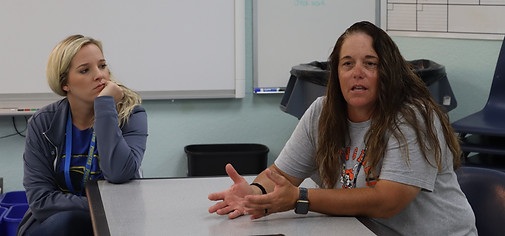
Linsenmeyer explains the program as Tate listens in
Linsenmeyer commends Tate for her work in the program. “As a parent of a special-needs person, I think one of the things that was important to me is socializing him and getting him out into the community,” Linsenmeyer said, “I’ve been here—this is my tenth year—and it’s just getting better every year.”
Interactions between the students and life lessons from these experiences are what make Tate, Linsenmeyer, and Dr. Schell proud to teach and take part in the programs provided in the Stillwater High School and beyond.
“We rarely deal with the general population too much but the impact that being a Peer Advocate or a Peer Partner can have on our general education students is tremendous,” Linsenmeyer states, “I’m able to get the different populations on campus involved.”
Tate remembers being in schools where programs like Peer Partners were not available and it disappoints her. That is why she encourages everybody to join similar programs. “It’s absolutely worth every bit of it because the benefits are just never ending,” Tate says.
For Dr. Schell, a student pursuing an undergraduate minor in Special Education shows commitment. “I think overall, all teachers want to do right by all kids,” Dr. Schell said, “[Pursuing the degree] tells me that some of these up-and-coming teachers know that they need to serve and they will be serving individuals with disabilities in their classrooms.”
“It’s something that they can carry on for their whole life,” Linsenmeyer said, “because I know that it’s changed me as a person to not only have a child [with special-needs] but also my interaction with all the different disabilities and such. It’s made me a better person.”